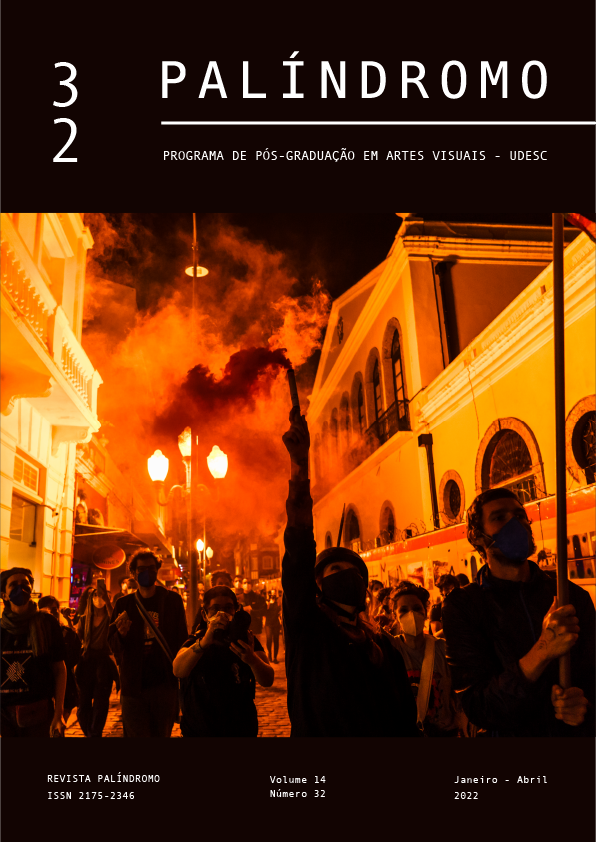Fricções e aproximações do ensino da arte na educação infantil: formação docente e arte contemporânea
DOI :
https://doi.org/10.5965/2175234614322022238Mots-clés :
Formação de professoras/es, Educação infantil, Ensino de arte, Arte contemporâneaRésumé
O artigo analisa, a partir da perspectiva histórico-cultural, questões pertinentes à formação inicial das/os professoras/es do Curso de Licenciatura em Artes Visuais – Integral (versão 2006), da Universidade Federal do Espírito Santo – UFES, e como essa formação reverbera nos modos de ensinar arte contemporânea na Educação Infantil que, em tempos de avanços tecnológicos significativos, tem redimensionado a forma das crianças produzirem e consumirem arte. Para tanto, realiza um estudo de caso a partir de entrevistas e diálogos com professoras desse segmento da educação básica. Fundamenta-se em Vigotski (2007) para abordar a perspectiva histórico-cultural no campo da psicologia, em Bakhtin (2010)), no campo da linguagem, e em Benjamin (2007) para pensar a criança. No campo do ensino da arte, apoia-se em Barbosa (2005) e em Cocchiarale (2006) e, para a formação de professores, em Fonseca da Silva (2019), em Foerste e Camargo (2019) e em Nóvoa (2009). Finaliza propondo uma aproximação entre a formação de professoras/es e a arte contemporânea, apresentando propostas educativas a partir de um ensino contemporâneo da arte para crianças pequenas.
Téléchargements
Références
BARBOSA, A. M. Uma introdução à Arte/Educação contemporânea. BARBOSA, A. M. In: Arte/educação contemporânea: consonâncias internacionais. São Paulo: Cortez, 2005.
BAKHTIN, M. Problemas da poética de Dostoiévski. Rio de Janeiro: Forense Universitária, 2010.
BENJAMIN, W. Reflexões sobre a criança, o brinquedo e a educação, 34. ed. São Paulo: Duas Cidades, 2007.
BRASIL. Base Nacional Comum Curricular (BNCC, 2017). Disponível em: http://basenacionalcomum.mec.gov.br/images/BNCC_publicacao.pdf. Acesso em 24 de
julho de 2017, às 16h. p. 31-51.
BRASIL. Resolução CNE/CP 2/2019. Diário Oficial da União, Brasília, 15 de abril de 2020, Seção 1, pp. 46-49.
COCCHIARALE, F. Quem tem medo da arte contemporânea. Recife: Massangana, 2006.
COCCHIARALE, F. O espaço da arte contemporânea. 2009. Disponível em: https://pt.scribd.com/doc/13092951/O-espaco-da-arte-contemporanea-FernandoCocchiarale. Acesso em: 25 Agosto 2021.
FOERSTE, G. M. S.; CAMARGO, F. M. B. A formação de professores no estado do Espírito Santo: mediações na licenciatura em artes visuais. Revista Espaço do Currículo (online). João Pessoa, v.12, n.3, p. 304-321, set/dez. 2019.
FONSECA DA SILVA, M. C. Políticas e currículo na licenciatura em artes visuais: pesquisas do Observatório da Formação de Professores no âmbito do Ensino de Arte (OFPEA/BRARG). Revista Espaço do Currículo (online), João Pessoa, v.12, n.3,
p. 233-251, set/dez. 2019.
GÓES. M. S. Rupturas e resistências para um ensino contemporâneo da arte. Anais do VII Colóquio de arte e pesquisa dos alunos do Programa de Pós-graduação em artes da Universidade Federal do Espírito Santo - COLARTES: há um lugar
para a arte? Centro de Artes – UFES | Vitória/ES, 2019.
NÓVOA, A. Professores: Imagens do futuro presente. Lisboa: Educa, 2009.
ROCHA, J. Ensino (contemporâneo) da arte contemporânea – Similitudes e enfrentamentos entre metodologia e conteúdo. In: Anais do 27º Encontro da Associação Nacional dos Pesquisadores em Artes plásticas. São Paulo, 2018. Disponível em: http://anpap.org.br/anais/2018/content/PDF/27encontroROCHA_Julia.pdf. Acesso em: 01 de abr. 2021.
VIGOTSKI, L. S. A formação social da mente: o desenvolvimento dos processos psicológicos superiores. 7. ed. São Paulo: Martins Fontes, 2007.
Téléchargements
Publiée
Comment citer
Numéro
Rubrique
Licence
(c) Tous droits réservés Margarete Sacht Góes, Angélica Vago Soares 2021

Ce travail est disponible sous la licence Creative Commons Attribution 4.0 International .
DECLARAÇÃO DE DIREITOS AUTORAIS
a. Os artigos publicados pela revista são de uso gratuito, destinados a aplicações acadêmicas e não comerciais. Todos os direitos autorais são atribuídos à revista. Os artigos cujos autores são identificados representam a expressão do ponto de vista de seus autores e não a posição oficial da Revista Palíndromo. O (s) autor (es) compromete-se sempre que publicar material referente ao artigo publicado no Palíndromo mencionar esta publicação da seguinte forma:
Este artigo foi publicado originalmente pela revista Palíndromo em seu volume (coloque o volume), número (coloque o número) no ano de (coloque o ano) e pode ser acessado em: http://www.revistas.udesc.br/index.php/palindromo
b. Plágio, em todas as suas formas, constitui um comportamento antiético de publicação e é inaceitável. A revista Palíndromo utiliza o software iThenticate de controle de similaridade


